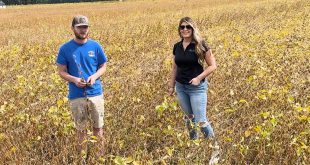Crop biological products are natural inputs comprised of bacterial strains that support a healthy soil environment, promote plant vigor and boost yield potential. BigBioYield, a crop biological from Missouri-based BigYield.us, combines multiple beneficial bacterial strains into a polymicrobial blend. In soybeans, applying BigBioYield can aid growers in managing soybean sudden death syndrome (SDS), a disease that can have an economically significant effect on yield.

Primarily, SDS stems from the Fusarium viruliforme pathogen, which may overwinter in soybean cyst nematode cysts, crop residues or the soil itself. Fields infected with both the Fusarium viruliforme pathogen and soybean cyst nematodes have greater SDS infection risk. Also, early-planted fields with cool wet and compacted soils have greater SDS susceptibility.
When present in fields, the fungus attacks seedling roots and stem tissue near the soil surface. It produces toxins that migrate through the stem and into the soybean canopy. Although the SDS infection starts at the seedling stage, growers won’t notice symptoms until the reproductive stage. By that point, yield losses are inevitable. During 2014, BigYield.us professionals note that 20 percent soybean yield losses attributed to SDS were common in some Missouri fields.
From a management perspective, growers have had relatively few options for addressing SDS. After the pathogen infects a field, conventional fungicides are ineffective. Crop rotation also doesn’t effectively mitigate the SDS threat. Some soybean varieties have a degree of SDS resistance; however, such varietal choices can be limited.
As a crop biological, BigBioYield uses two main mechanisms to reduce SDS infection and its effects. First, the product’s polymicrobial blend can suppress both nematodes and fungal pathogens, which are key SDS contributors. For example, BigBioYield bacterial components produce chitanase enzymes, which are known to suppress nematodes.
Second, BigBioYield includes plant growth-promoting rhizobacteria. These rhizobacteria encourage early root development; suppress soil-borne disease; produce auxins, gibberillans and Indole acetic acid, which are compounds that promote growth; and aid in efficient nitrogen, phosphorus, potassium and water use. Their presence ultimately leads to quicker crop development and reduced impact from SDS infection.
 In addition to arming soybean producers with an option to manage SDS, the BigBioYield polymicrobial blend also has three key soil health benefits for a wider range of crops. First, the polymicrobial blend creates enzymatic activity that converts otherwise unavailable nutrients bound to the soil into forms that plants may absorb and use. For example, biological products may solubilize phosphorus and make it available for absorption. Second, adding beneficialbacteria to the soil protects plants from soil-borne pathogens and diseases. Third, biological products trigger feeder root and early root system development. During the growing season, a well-developed root system facilitates improved nutrient uptake and plant growth. After harvest, the large root ball remains in the soil and eventually breaks down into organic matter that enriches the soil.
In addition to arming soybean producers with an option to manage SDS, the BigBioYield polymicrobial blend also has three key soil health benefits for a wider range of crops. First, the polymicrobial blend creates enzymatic activity that converts otherwise unavailable nutrients bound to the soil into forms that plants may absorb and use. For example, biological products may solubilize phosphorus and make it available for absorption. Second, adding beneficialbacteria to the soil protects plants from soil-borne pathogens and diseases. Third, biological products trigger feeder root and early root system development. During the growing season, a well-developed root system facilitates improved nutrient uptake and plant growth. After harvest, the large root ball remains in the soil and eventually breaks down into organic matter that enriches the soil.
For more information about BigBioYield and its effect on soil health, go to www.bigyield.us.
 BigYield High Yield Soybeans, High Yield Corn, and High Yield Wheat
BigYield High Yield Soybeans, High Yield Corn, and High Yield Wheat




Have you heard of Paul Stamets, mycologist, & his patent for controlling crop damaging insects? The reading is interesting & the claims profound; as far reaching as being the potential demise of Monsanto. Am having trouble finding any research results, though. How effectively do the smart biopesticides compete with traditional chemical pesticides?
The reading is dry & technical, but here is the link to the patent:
http://www.google.com/patents/US7122176